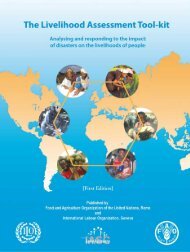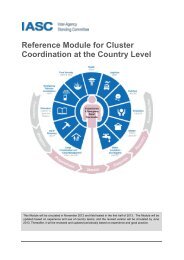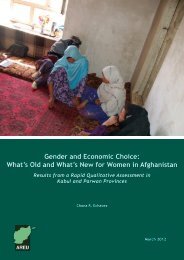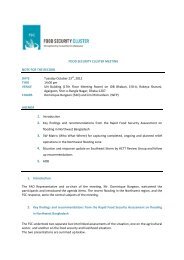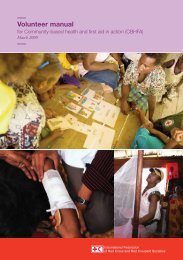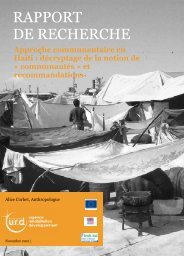Figure 1Source: Special Inspector General for Afghanistan Reconstruction,“Quarterly Report to the U.S. Congress” (April 30, 2011),142–3.The contemporary origins of militaryinvolvement in delivering assistance lie in theAllied preparations for the invasions of NorthAfrica <strong>and</strong> Western Europe in the course ofWorld War II. However, it is perhaps morestrongly associated with the Cold Warcounterinsurgency campaigns of the 1950sthrough the 1970s, principally the Britishexperiences in Malaya, Oman, <strong>and</strong> Aden(Yemen), <strong>and</strong> the U.S. experience in Vietnam.The phrase “hearts <strong>and</strong> minds” is usuallyassociated with Field Marshal Sir GeraldTempler, 15 <strong>and</strong> his ultimately successful conductof the British-led counter insurgency campaignin Malaya (1948–60). Since the “MalayanEmergency,” the phrase has often been used as aform of shorth<strong>and</strong> for the overall Britishapproach to counter-insurgency: emphasizingwinning the “hearts <strong>and</strong> minds” of thepopulation through securing the support of thepeople. The approach shaped British strategyboth in Malaya <strong>and</strong> in dealing with the MauMau rebellion in Kenya. In the 1970s, it wasinfluential in Northern Irel<strong>and</strong>. The kernel ofthe strategy was to establish secure zones, useminimum force, apply development, <strong>and</strong> addresspolitical grievances that underlay the rebellions— all in order to turn the population against theinsurgents. At the same time, outside of thesecure areas, the strategy was to implementmilitary measures designed to inflict attrition onthe military component of the insurgency. Thisapproach has been contrasted with tactics thatstress more conventional military means, are lessfocused on developing the support of thepopulation, <strong>and</strong> are less concerned with avoidingcivilian casualties.The U.S. experience began as Civil Affairs inWorld War II but has echoed the British path inits association with counter-revolutionary warfare,particularly in programs such as the CivilOperations <strong>and</strong> Revolutionary DevelopmentSupport Program (or CORDS) during theVietnam War. These counter-insurgencyapproaches tended to bring together efforts toseparate the population from the insurgents whileproviding a variety of reconstruction programs towin over the sympathy of the population. Thephrase “hearts <strong>and</strong> minds” was also associatedwith the U.S. military <strong>and</strong> strategies adopted tocontain the communist insurgency in Vietnam.President Lyndon B. Johnson is quoted in May1965 when he argued that U.S. victory would bebuilt on the “hearts <strong>and</strong> minds of the people whoactually live out there. By helping to bring themhope <strong>and</strong> electricity you are also striking a veryimportant blow for the cause of freedomthroughout the world.” 16 This approach shapedboth U.S. strategy <strong>and</strong> rhetoric on the war inIndo-China <strong>and</strong> led to efforts to coordinatedevelopment <strong>and</strong> security approaches that wouldcounter communist propag<strong>and</strong>a <strong>and</strong> isolate theinsurgents from the people. Under Johnson theU.S. “committed itself to ‘pacification’ of SouthVietnam by providing both security <strong>and</strong>development support. U.S. officials, both civilian<strong>and</strong> military, would provide ‘advice’ <strong>and</strong> resourcesfor economic development projects, such asrebuilding roads <strong>and</strong> bridges, while the militarywould train <strong>and</strong> equip South Vietnam’s police <strong>and</strong>paramilitary groups to hunt down insurgents.” 1715John Cloake, Templer: Tiger of Malaya: The Life of Field Marshal Sir Gerald Templer (London: Harrap, 1985). Footnote 1 states that Templerfirst used the term on April 26, 1952.16Lyndon B. Johnson quoted in Francis Njubi Nesbitt, “<strong>Hearts</strong> <strong>and</strong> <strong>Minds</strong> <strong>and</strong> Empire.” Foreign Policy in Focus (March 20, 2009), http://www.fpif.org/articles/hearts_<strong>and</strong>_minds_<strong>and</strong>_empire.17Ibid.14Feinstein International Center
2.1 Current approachesRecognition that the causes of instability arecomplex has driven the formulation of the variousmodels, such as the“ comprehensive approach,”“3D” (defense, diplomacy, development), “wholeof government,” <strong>and</strong> “integrated approach.”These trends are discernible in a range ofinternational organizations (particularly the EU<strong>and</strong> NATO) as well as between <strong>and</strong> withinministries in individual states. For example, in2004, the UK government established a Post-Conflict Reconstruction Unit (renamed theStabilisation Unit in 2007), jointly owned by theMinistry of Defense (MOD), Foreign <strong>and</strong>Commonwealth Office (FCO) <strong>and</strong> Departmentfor International Development (DFID); in 2004,the U.S. Congress appropriated funds for the U.S.State Department to establish the Office of theCoordinator for Reconstruction <strong>and</strong> Stabilization(S/CRS); <strong>and</strong> in 2005, the Canadian governmentestablished the Stabilisation <strong>and</strong> ReconstructionTask Force (START) within its Department ofForeign Affairs <strong>and</strong> International Trade.The various models are all derived from thesense that the origins of conflict are largelysocio-economic in nature, <strong>and</strong> that state failureis a consequence of the breakdown of publicservice delivery. Militaries have been attractedto comprehensive or integrative approaches fora variety of reasons related both to theories ofconflict causation <strong>and</strong> resolution <strong>and</strong> to thenecessity for “soft power” to contribute to“force protection.” 18 In terms of theories aboutwhat causes conflicts <strong>and</strong> how they are resolved,conflict is frequently portrayed as a product oflow levels of development as well as political<strong>and</strong> social marginalization. In the course of aninternational military intervention, it is oftenassumed that tactical military progress cannotbe consolidated or translated into strategicsuccess, <strong>and</strong> viable states cannot be built,without the host government constructinglegitimacy through the provision of publicservices. In terms of force protection, thetheory is that when an international militaryforce provides infrastructure <strong>and</strong> “facilities”(such as public health clinics, wells, <strong>and</strong> schools)the population will be encouraged intocollaborative relationships with theinternational military—reducing opportunitiesfor insurgents <strong>and</strong> providing intelligence to thecounter-insurgent forces.The U.S. DOD has made considerable efforts todevelop the capacities for “stability operations” 19<strong>and</strong> to link these with the work of theDepartment of State <strong>and</strong> USAID—the result isan approach to security that makes afundamental break with the past. The principalchange has been a reorientation to meet adifferent perceived threat. The 2002 U.S.National Security Strategy stated that the U.S.“is now threatened less by conquering statesthan we are by failing ones.” Then Secretary ofDefense, Robert M. Gates, argued that even theemphasis on regime change that dominatedbetween 2001 <strong>and</strong> 2003 had changed:Repeating an Afghanistan or an Iraq—forcedregime change followed by nation-building underfire—probably is unlikely in the foreseeablefuture. What is likely though, even a certainty, isthe need to work with <strong>and</strong> through localgovernments to avoid the next insurgency, torescue the next failing state, or to head off thenext humanitarian disaster.Correspondingly, the overall posture <strong>and</strong> thinkingof the United States armed forces has shifted—away from solely focusing on direct Americanmilitary action, <strong>and</strong> towards new capabilities toshape the security environment in ways that obviatethe need for military intervention in the future. 20In 2005 the DOD issued “DOD Directive3000.05” (2005), emphasizing the importance18Force protection consists of preventive measures intended to reduce hostile actions against military personnel, resources, facilities, <strong>and</strong>information.19DOD defines stability operations as “An overarching term encompassing various military missions, tasks, <strong>and</strong> activities conducted outsidethe United States in coordination with other instruments of national power to maintain or reestablish a safe <strong>and</strong> secure environment,provide essential governmental services, emergency infrastructure reconstruction, <strong>and</strong> humanitarian relief.” See Headquarters Departmentof the Army, “Stability Operations,” FM 3-07 (December 2008), Glossary, p. 9.20Robert M. Gates. (U.S. Secretary of Defense) “U.S. Global Leadership Campaign.” Speech given on July 15, 2008 at the U.S. GlobalLeadership Campaign (Washington, DC). http://www.defenselink.mil/speeches/speech.aspx?speechid=1262.<strong>Winning</strong> <strong>Hearts</strong> <strong>and</strong> <strong>Minds</strong>? Examining the Relationship between Aid <strong>and</strong> Security in Afghanistan 15







